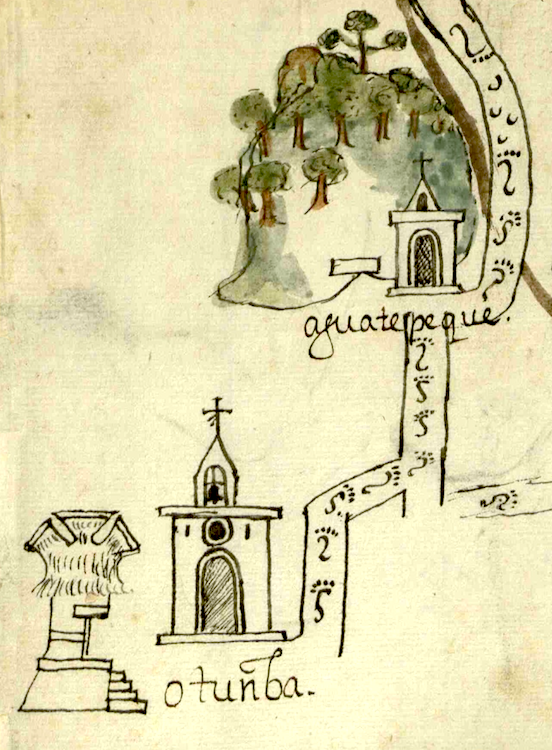Ahuatepec (T2782:15:17r)
This compound place glyph consists of two main elements, a hill (tepetl) topped by an oak tree (ahuatl), combining to indicate the place name Ahuatepec ("On Oak Hill," in the Otumba region; see gloss, below). The oak tree stands out in a frontal view with three branches, each with green foliage at the ends, with those branches and the trunk painted in brown. The green-washed and neutral-toned hill is covered with other less-defined trees on its slopes. These trees seem to be semantic elements indicating that the hill is wooded. The hill also has a horizontal white bar near the base, which is typically the site from which a natural spring might emerge. Another semantic element is the image of a European-style church on the lower right side of the hill, undoubtedly there to emphasize that the whole thing serves as a place glyph for the community of Ahuatepec. Otherwise, the -c locative is not obviously visualized.
Robert Haskett
This compound place glyph for Ahuatepec, a subject community under the authority of the cabecera (head town) of Otompan (also spelled Otumba), appears on a pictorial manuscript dating from around 1590. The manuscript is included among the records of an investigation of the possible alienation of land in the region administered by the Nahua town council of Otumba (see historical contextualizing image). The property in question was located near Ahuatepec as well as two other dependent pueblos, Axoloapan and Calpollalpan (also spelled Calpullalpan). These towns were potentially affected by a pending grant of a sitio de estancia de ganado menor (ranch for small livestock) and two caballerías of land requested by the Spaniard Antón de Loza Moreno. It is interesting to note that this late sixteenth-century place glyph, heavily influenced by Spanish culture while still retaining some basic Indigenous elements, not only includes the new element of a Catholic church--with its arched entrance and cross on the tower--but also shows the tepetl as being wooded, apparently another artistic innovation, where the mechanics of creating a glyph is evolving into a landscape painting with shading (which gives it a three-dimensionality, too). While the oak tree resembles examples found in the Codex Mendoza, it lacks the water (atl) elements found emerging form the foliage, as seen in that earlier manuscript (see comparative image, below). For some concise information about ahuatl trees, see https://es.wiktionary.org/wiki/ahuatl.
Robert Haskett
aguatepeque
Ahuatepec
Robert Haskett
1590
Robert Haskett
place names, nombres de lugares, topónimos, oak trees, robles, hills, mountains, cerros, árboles, churches, iglesias
The mapa from AGN Tierras vol. 2782, expediente 15, folio 17 recto.

ahua(tl), oak tree, also a surname, https://nahuatl.wired-humanities.org/content/ahuatl-0
tepe(tl), hill, mountain, precipice, https://nahuatl.wired-humanities.org/content/tepetl
En el Cerro del Roble
Stephanie Wood
Single-page pictographic manuscript, Archivo General de la Nación, México, Ramo de Tierras Vol. 2782, Exp. 15, Fol. 17r.
The Archivo General de la Nación (AGN), México, holds the original manuscript. This image is published here under a Creative Commons license, asking that you cite the AGN and this Visual Lexicon of Aztec Hieroglyphs.






